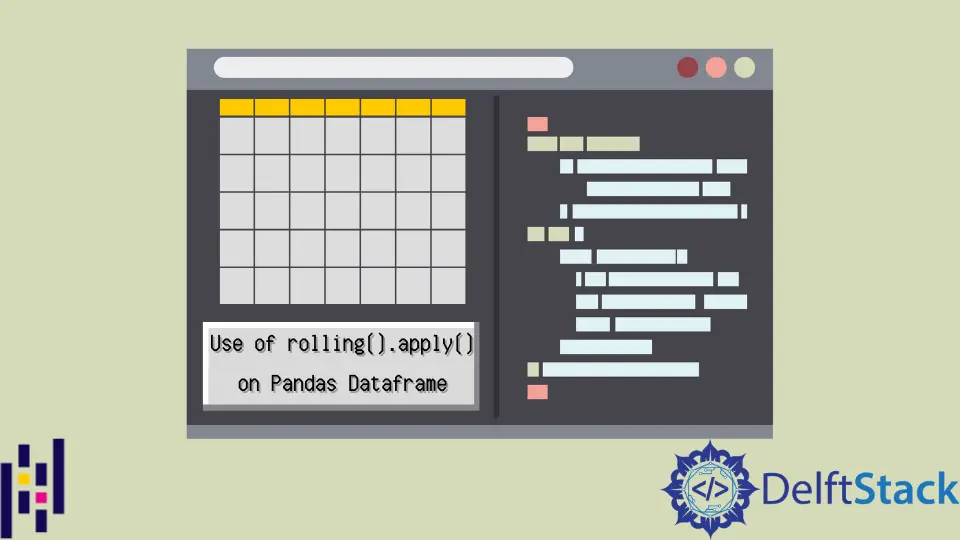Pandas Dataframe 및 Series에서 rolling().apply() 사용
-
Pandas DataFrame에서
rolling().apply()사용 -
Lambda를 사용한
rolling.apply -
Pandas Series에서
rolling().apply()사용

Pandas 라이브러리에는 많은 유용한 기능이 있으며 rolling()은 지정된 데이터 세트에서 복잡한 계산을 수행할 수 있는 기능 중 하나입니다. 또한 롤링 윈도우가 있는 특정 함수/메소드를 전체 데이터에 적용하는 apply()라는 메서드가 있습니다.
Python 계열 및 데이터 프레임과 함께 rolling().apply()를 사용할 수 있습니다. 이 튜토리얼은 rolling() 및 apply() 메서드에 대해 교육하고 Pandas 데이터 프레임 및 시리즈에서 rolling().apply()를 사용하는 방법도 보여줍니다.
Pandas DataFrame에서 rolling().apply() 사용
데이터 프레임에서 rolling().apply() 사용법을 단계별로 살펴보겠습니다.
-
라이브러리를 가져옵니다.
import pandas as pd import numpy as np먼저
numpy.median()함수를 사용하는 동안 필요한 라이브러리인 데이터 프레임을 가지고 놀기 위한pandas와 배열로 작업하기 위한numpy를 가져옵니다. -
데이터 프레임을 만듭니다.
points_df = pd.DataFrame( { "Team_A": [12, 23, 34, 45, 32, 45, 32, 21, 33], "Team_B": [13, 24, 35, 46, 33, 46, 33, 22, 34], "Team_C": [14, 25, 36, 47, 34, 47, 34, 23, 35], "Team_D": [15, 26, 37, 48, 35, 48, 35, 24, 36], } ) print(points_df)출력:
Team_A Team_B Team_C Team_D 0 12 13 14 15 1 23 24 25 26 2 34 35 36 37 3 45 46 47 48 4 32 33 34 35 5 45 46 47 48 6 32 33 34 35 7 21 22 23 24 8 33 34 35 36다음으로
Team_A,Team_B,Team_C및Team_D에 대한 서로 다른 포인트를 포함하는points_df라는 데이터 프레임을 만듭니다. 기본 인덱스에 헤더(제목)가 없음을 알 수 있습니다.다음 단계에서 제목을 만들어 보겠습니다.
-
기본 열 인덱스에 대한 제목을
인덱스로 설정합니다.points_df.index.names = ["index"] print(points_df)출력:
Team_A Team_B Team_C Team_D index 0 12 13 14 15 1 23 24 25 26 2 34 35 36 37 3 45 46 47 48 4 32 33 34 35 5 45 46 47 48 6 32 33 34 35 7 21 22 23 24 8 33 34 35 36보시다시피 제목
index는Team_A,Team_B,Team_C및Team_D와 정렬되지 않습니다. 다음 단계에서 해보자. -
points_df데이터 프레임의 모든 제목을 정렬합니다.points_df.columns.name = points_df.index.name points_df.index.name = None print(points_df)출력:
index Team_A Team_B Team_C Team_D 0 12 13 14 15 1 23 24 25 26 2 34 35 36 37 3 45 46 47 48 4 32 33 34 35 5 45 46 47 48 6 32 33 34 35 7 21 22 23 24 8 33 34 35 36 -
calculate_median()함수를 생성합니다.def calculate_median(n): return np.median(n)이 함수는 계열(숫자 값의 배열이라고 할 수 있음)을 사용하여 해당 계열의 중앙값을 반환합니다.
-
points_df데이터 프레임에서rolling().apply()를 사용하십시오.points_df = points_df.rolling(2).apply(calculate_median) print(points_df)출력:
index Team_A Team_B Team_C Team_D 0 NaN NaN NaN NaN 1 17.5 18.5 19.5 20.5 2 28.5 29.5 30.5 31.5 3 39.5 40.5 41.5 42.5 4 38.5 39.5 40.5 41.5 5 38.5 39.5 40.5 41.5 6 38.5 39.5 40.5 41.5 7 26.5 27.5 28.5 29.5 8 27.0 28.0 29.0 30.0여기서
rolling()은 롤링 창 계산을 제공하는 데 사용됩니다. 이 아이디어(롤링 창)는 신호 프로세스 및 시계열 데이터 세트에 사용됩니다.우리는 이미
rolling(), 구문, 롤링 창 기능 및 다양한 롤링 기능을 보여줌으로써 작업 프로세스에 대한 기사를 작성했습니다. 여기에서 읽을 수 있습니다.우리는
apply()함수를 사용하여 지정된 데이터에 사용자 지정 함수(우리의 경우calculate_median())를 적용합니다. -
다음은 전체 소스 코드입니다.
import pandas as pd import numpy as np points_df = pd.DataFrame( { "Team_A": [12, 23, 34, 45, 32, 45, 32, 21, 33], "Team_B": [13, 24, 35, 46, 33, 46, 33, 22, 34], "Team_C": [14, 25, 36, 47, 34, 47, 34, 23, 35], "Team_D": [15, 26, 37, 48, 35, 48, 35, 24, 36], } ) points_df.index.names = ["index"] points_df.columns.name = points_df.index.name points_df.index.name = None print("Before rolling().apply():\n\n") print(points_df) def calculate_median(n): return np.median(n) points_df = points_df.rolling(2).apply(calculate_median) print("\n\nBefore rolling().apply():\n\n") print(points_df)출력:
Before rolling().apply(): index Team_A Team_B Team_C Team_D 0 12 13 14 15 1 23 24 25 26 2 34 35 36 37 3 45 46 47 48 4 32 33 34 35 5 45 46 47 48 6 32 33 34 35 7 21 22 23 24 8 33 34 35 36 Before rolling().apply(): index Team_A Team_B Team_C Team_D 0 NaN NaN NaN NaN 1 17.5 18.5 19.5 20.5 2 28.5 29.5 30.5 31.5 3 39.5 40.5 41.5 42.5 4 38.5 39.5 40.5 41.5 5 38.5 39.5 40.5 41.5 6 38.5 39.5 40.5 41.5 7 26.5 27.5 28.5 29.5 8 27.0 28.0 29.0 30.0
Lambda를 사용한 rolling.apply
다음 코드를 고려하십시오.
from sklearn.preprocessing import StandardScaler
import pandas as pd
import numpy as np
def test(df):
return np.mean(df)
sc = StandardScaler()
tmp = pd.DataFrame(
np.random.randn(2000, 2) / 10000,
index=pd.date_range("2001-01-01", periods=2000),
columns=["A", "B"],
)
print("Test 1: ")
print(tmp.rolling(window=5, center=False).apply(lambda x: test(x)))
print("SC_Fit: ")
print(
tmp.rolling(window=5, center=False).apply(
lambda x: (x[-1] - x.mean()) / x.std(ddof=1)
)
)
출력:
Test 1:
A B
2001-01-01 NaN NaN
2001-01-02 NaN NaN
2001-01-03 NaN NaN
2001-01-04 NaN NaN
2001-01-05 -0.000039 0.000053
... ... ...
2006-06-19 0.000022 -0.000021
2006-06-20 0.000005 -0.000027
2006-06-21 0.000024 -0.000060
2006-06-22 0.000023 -0.000038
2006-06-23 0.000014 -0.000017
[2000 rows x 2 columns]
SC_Fit:
A B
2001-01-01 NaN NaN
2001-01-02 NaN NaN
2001-01-03 NaN NaN
2001-01-04 NaN NaN
2001-01-05 -0.201991 0.349646
... ... ...
2006-06-19 1.035835 -0.688231
2006-06-20 -0.595888 1.057016
2006-06-21 -0.640150 -1.399535
2006-06-22 -0.535689 1.244345
2006-06-23 0.510958 0.614429
[2000 rows x 2 columns]
lambda 함수의 x는 (롤링) 계열/ndarray를 나타내므로 함수는 다음과 같이 작성할 수 있습니다(여기서 x[-1]은 현재 롤링 데이터 포인트를 나타냄).
lambda x: (x[-1] - x.mean()) / x.std(ddof=1)
Pandas Series에서 rolling().apply() 사용
마찬가지로 Pandas 시리즈에 rolling().apply()를 사용할 수 있습니다. 다음 코드 펜스는 한 가지 차이점을 제외하고 Pandas 데이터 프레임에 대해 작성한 것과 동일합니다. 여기서 시리즈를 사용하고 있습니다.
전체 소스 코드는 아래에 제공되지만 시리즈에 대한 자세한 내용은 여기에서 읽을 수 있습니다.
예제 코드:
import pandas as pd
import numpy as np
points_series = pd.Series(
[12, 23, 34, 45], index=["Team_A", "Team_B", "Team_C", "Team_D"]
)
print("Before rolling().apply():\n\n")
print(points_series)
def calculate_median(n):
return np.median(n)
points_series = points_series.rolling(2).apply(calculate_median)
print("\n\nBefore rolling().apply():\n\n")
print(points_series)
출력:
Before rolling().apply():
Team_A 12
Team_B 23
Team_C 34
Team_D 45
dtype: int64
Before rolling().apply():
Team_A NaN
Team_B 17.5
Team_C 28.5
Team_D 39.5
dtype: float64
